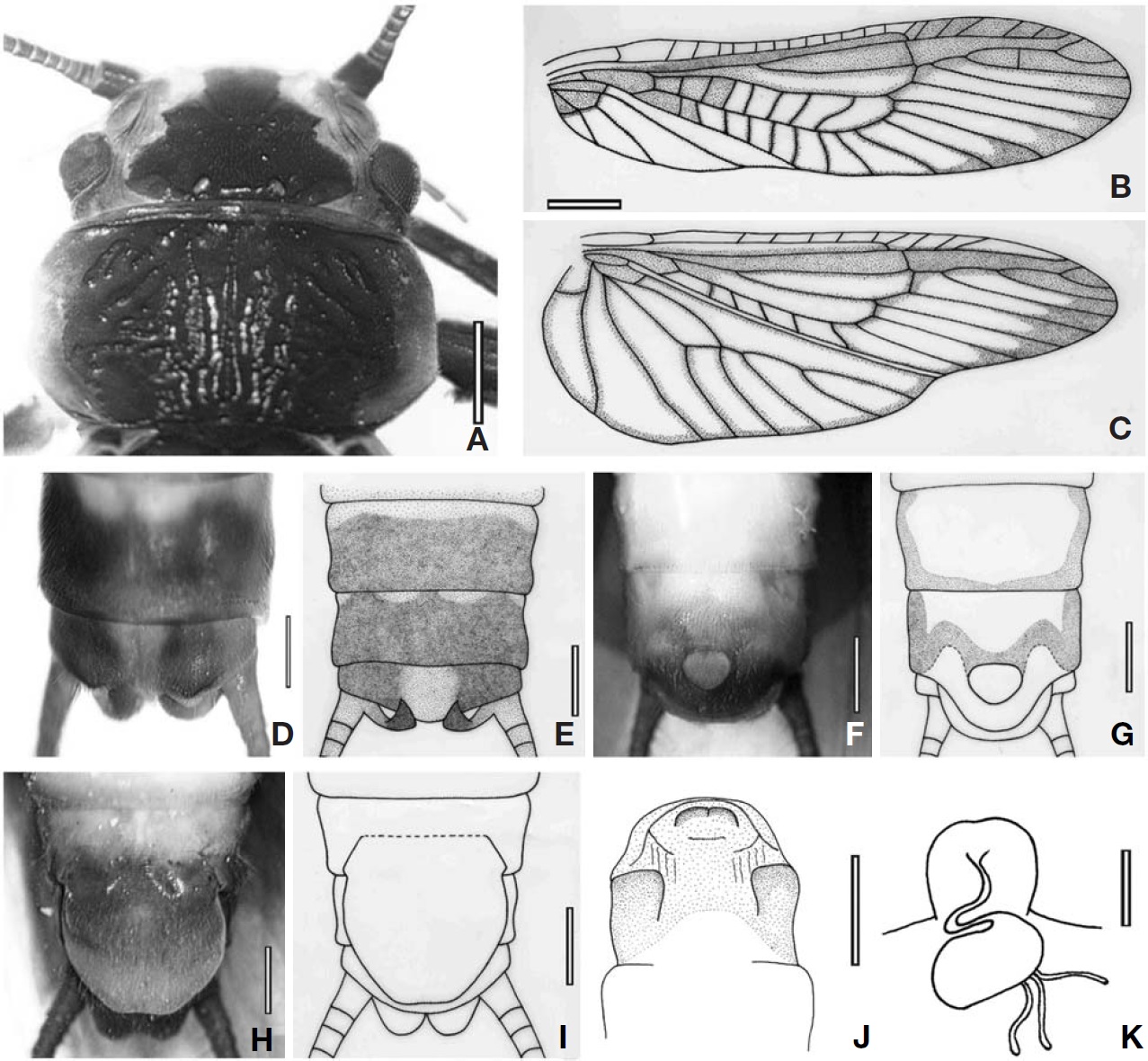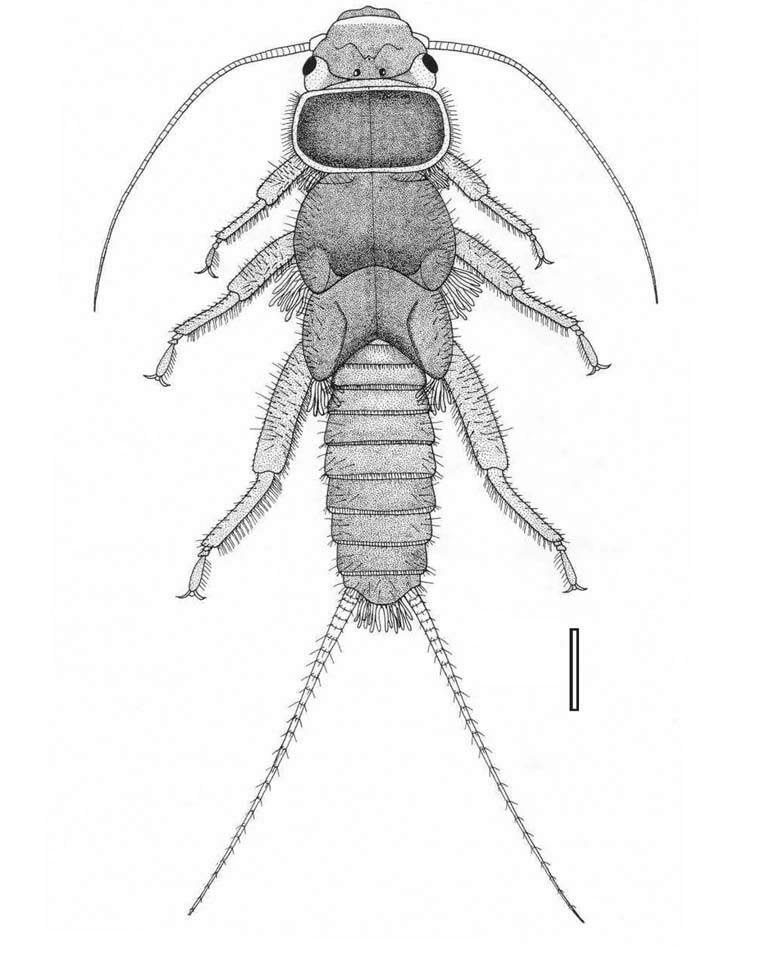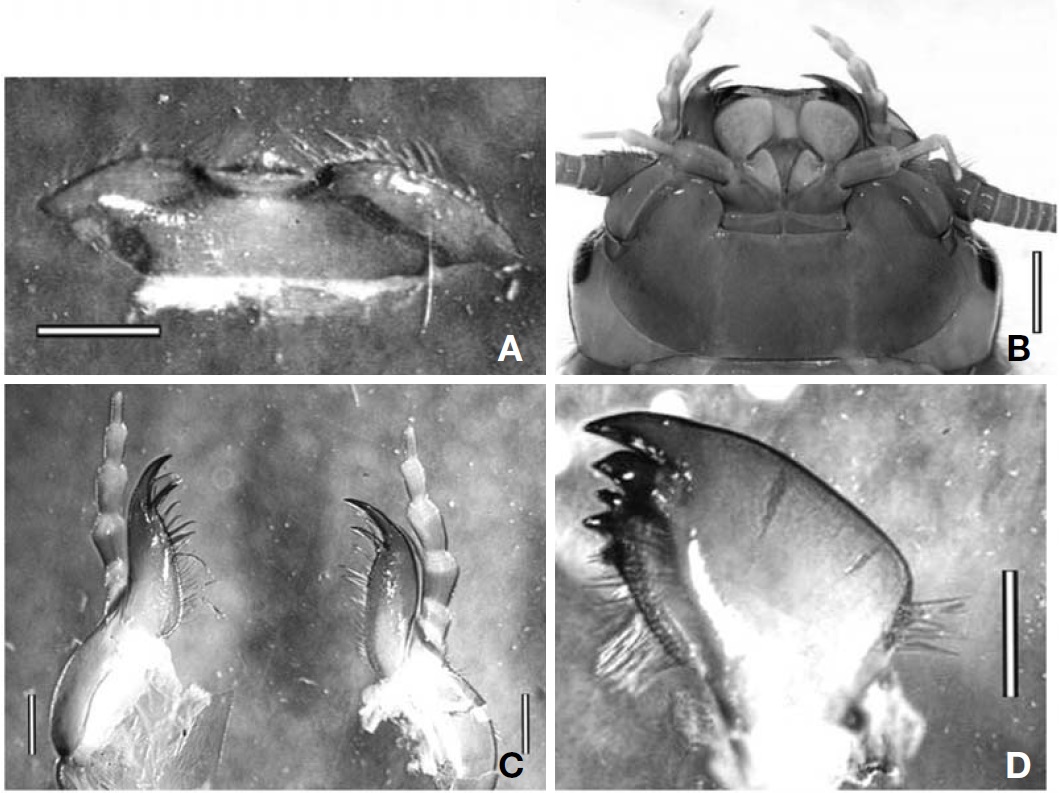



The perlid stonefly Brahmana flavomarginata Wu, originally described from China from the male adult, is described using reared male and female adults and nymphs from Vietnam. The male adult of B. flavomarginata is distinguished from its congeners by the blackish-brown body color and distinct head marking, hemitergal triangular chitin plates, and a median semicircular smooth subgenital plate (hammer) on the abdominal sternum IX. The female adult has a large and round subgenital plate which extends to the posterior margin of the abdominal sternum X. The nymph can be distinguished by the relatively small compound eyes and the body covered by many long stout setae and short golden brown hair-like setae. This species is known in southwestern China (Yunnan Province) and northern Vietnam (Lao Cai Province, Cao Bang Province).
The tropical or subtropical stonefly genus
Members of
We have investigated
Adult specimens were collected by a sweep net and a light trap. Nymphs were collected by a hand net. Last instar nymphs were reared in the field to associate the adults. All materials were preserved in 80% EtOH, and housed in the Entomological Museum of Korea University (KU) in Seoul, Korea and the Institute of Ecology and Biological Resources (IEBR) in Hanoi, Vietnam. Morphological terminology follows Stark and Gaufin (1976).
Order Plecoptera Burmester
Family Perlidae Latreille
Genus Brahmana Klapalek
Brahmana Klapalek, 1914: 67.
Type species.
Brahmana flavomarginata Wu(Figs. 1-3)
Material examined. 7 male adults (SWU-PLE-53, 54, reared), 2 female adults(SWU-PLE-52, reared), 2 nymphs(SWUPLE- 51), Thac Bac (22°21′887′′N, 103°46′666′′E), alt. 2,000 m, Sa Pa, Lao Cai Province, Northern Vietnam, 22 Apr 2002, Hoang Duc Huy and Nguyen Van Vinh [KU]; 2 nymphs (IEBR-PLE-50), Nam Toong (22°32′643′′N, 105°51′494′′E),
Nguyen Binh, Cao Bang Province, Northern Vietnam, 11 May 2010, Thi Kim Thu Cao [IEBR].
Male adult. Body length 15.6-17.5 mm; antennae 10.1-13.4 mm; forewings 16.5-18.3 mm; hindwings 15.3-16.6 mm. General body color blackish-brown. Head (Fig. 1A) slightly narrower than pronotum, with a triangular darkened area centrally. Three small ocelli present; anterior ocellus somewhat indistinct. Antennae generally blackish-brown. Pronotum (Fig. 1A) blackish-brown, oval; lateral margins lighter in color. Wings (Fig. 1B, C) subhyaline, somewhat smoky at tip and along veins; veins brown. Forewing Rs with 4 branches; C-Sc with 19 crossveins. Hindwing 3A unforked. Legs
unicolored in blackish-brown. Abdomen cylindrical, blackish- brown; abdominal terga I-X unmodified. Paraprocts (Fig. 1D, E) modified to hemitergal; hemitergal triangular chitin plates recurved backward and upward, slightly extended over posterior margin of abdominal tergum X. Subgenital plate (Fig. 1F, G) on abdominal sternum IX broadly rounded at posterior margin, covered almost entire area of abdominal sternum X, with a semicircular smooth hammer medially. Everted aedeagus sac (Fig. 1J) bare, relatively short and plump, ca. 0.7 mm long, lepidopteran pupa head-shaped in dorsal view; apical part armed with small sclerotized bilobed structure medially; basal part with a pair of longitudinal protrusions. Cerci blackish-brown; each joint with whorl of long setae on posterior margin.
Female adult. Body length 18.1-18.5 mm; forewings 18.5- 19.0 mm; hindwings 16.3-17.5 mm. Similar morphology to male but somewhat larger. Subgenital plate (Fig. 1H, I) relatively large, round, slightly narrowed posteriorly, and extending to posterior margin of abdominal sternum X. Vagina (Fig. 1K) small, membranous, and without anterior accessory glands. Spermatheca usually inflated and with several accessory glands; spermathecal stalk slender, slightly longer than vagina length.
Nymph. Body length 14.7-17.9 mm. General body (Fig. 2)
color yellowish-brown without distinct pattern; surface covered with many long stout setae and short golden brown hairlike setae. Head relatively wide, as wide as pronotum (head width 3.6-5.8 mm), flattened, with pale-brown to indistinct M-line; occipital ridge slightly convex at middle, without fringe of stout setae. Compound eyes relatively small and black. Three ocelli present; anterior ocellus very small, similar to black spot. Antennae long, ca. 1/2× as long as body length (antennae length 6.7-8.6 mm), yellowish-brown, with several minute hairs on scape. Mouthparts brown. Labrum (Fig. 3A) dorsally covered with black hair-like setae, ca. 4.0 × wider than long; anterior margins convex at middle, fringed with white silky hair-like setae. Labium (Fig. 3B) with well developed and round paraglossae; glossae greatly reduced; submentum very large, wider than long, with round margin; mentum reduced to narrow band; labial palp slender, 3- segmented (segments nearly equal in length). Hypopharynx triangular; anterior margin round and cover with patch of strong brown hair-like setae. Mandibles (Fig. 3D) asymmetrical; right mandible with six teeth and left mandible with five teeth; with two rows of setae on inner margin and ca. 10 setae on outer margin near base. Maxillae (Fig. 3C) well developed; lacinia bidentate; inner tooth ca. 2/3× as long as outer tooth; inner lacinial margin with ca. 5 large setae followed by a row of smaller setae; maxillary palps short and stout, 5-segmented (segments subequal in length). Pronotum quadrate, yellowish-brown, wider than long, with complete fringe of thick setae along lateral margin. Legs flattened, yellowishbrown; femora and tibiae covered with numerous stout setae. Abdomen cylindrical, yellowish-brown, covered with many long stout setae and short golden brown hair-like setae, with anal gills. Paraproct lobe quadrate. Cerci relatively long, as long as body length, yellowish-brown; each joint with whirl of stout setae on posterior margin.
Diagnosis. The male adult of
Distribution. Southwestern China (Yunnan Province), Northern Vietnam (Lao Cai Province, Cao Bang Province).
Remarks. In the genera of the tribe Acroneuriini,
Wu (1962) originally described


